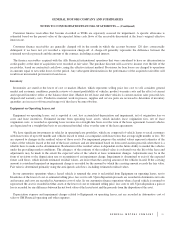General Motors 2014 Annual Report Download - page 72
Download and view the complete annual report
Please find page 72 of the 2014 General Motors annual report below. You can navigate through the pages in the report by either clicking on the pages listed below, or by using the keyword search tool below to find specific information within the annual report.GENERAL MOTORS COMPANY AND SUBSIDIARIES
NOTES TO CONSOLIDATED FINANCIAL STATEMENTS — (Continued)
GM Financial
The amounts presented for GM Financial have been adjusted to include the effect of our tax attributes on GM Financial’s deferred
tax positions and provision for income taxes since the date of acquisition, which are not applicable to GM Financial on a stand-alone
basis, and to eliminate the effect of transactions between GM Financial and the other members of the consolidated group.
Accordingly, the amounts presented will differ from those presented by GM Financial on a stand-alone basis.
Note 2. Significant Accounting Policies
The accounting policies which follow are utilized by our automotive and automotive financing operations, unless otherwise
indicated.
Revenue Recognition
Automotive
Automotive net sales and revenue are primarily composed of revenue generated from the sale of vehicles. Vehicle sales are
recorded when title and all risks and rewards of ownership have passed to our customers. For the majority of our automotive sales this
occurs when a vehicle is released to the carrier responsible for transporting to a dealer and when collectability is reasonably assured.
Vehicle sales are recorded when the vehicle is delivered to the dealer in most remaining cases. Provisions for recurring or announced
dealer and customer sales and leasing incentives, consisting of allowances and rebates, are recorded as reductions to Automotive net
sales and revenue at the time of vehicle sales. All other incentives, allowances and rebates related to vehicles previously sold are
recorded as reductions to Automotive net sales and revenue when announced.
Vehicle sales to daily rental car companies with guaranteed repurchase obligations are accounted for as operating leases. Estimated
lease revenue is recorded ratably over the estimated term of the lease based on the difference between net sales proceeds and the
guaranteed repurchase amount. The difference between the cost of the vehicle and estimated residual value is depreciated on a
straight-line basis over the estimated term of the lease.
Automotive Financing — GM Financial
Finance charge income earned on receivables is recognized using the effective interest method for consumer financing receivables and
accrual method for commercial financing receivables. Fees and commissions (including incentive payments) received and direct costs of
originating loans are deferred and amortized over the term of the related finance receivables using the effective interest method and are
removed from the consolidated balance sheets when the related finance receivables are sold, charged off or paid in full. Accrual of
finance charge income on consumer finance receivables is generally suspended on accounts that are more than 60 days delinquent,
accounts in bankruptcy and accounts in repossession. Payments received on nonaccrual loans are first applied to any fees due, then to any
interest due and then any remaining amounts are recorded to principal. Interest accrual generally resumes once an account has received
payments bringing the delinquency to less than 60 days past due. Accrual of finance charge income on commercial finance receivables is
generally suspended on accounts that are more than 90 days delinquent, upon receipt of a bankruptcy notice from a borrower, or where
reasonable doubt about the full collectability of contractually agreed upon principal and interest exist. Payments received on nonaccrual
loans are first applied to principal. Interest accrual resumes once an account has received payments bringing the account fully current and
collection of contractual principal and interest is reasonably assured (including amounts previously charged-off) or, for troubled debt
restructurings (TDRs), when repayment is reasonably assured based on the modified terms of the loan.
Income from operating lease assets, which includes lease origination fees, net of lease origination costs and incentives, is recorded
as operating lease revenue on a straight-line basis over the term of the lease agreement.
72
























